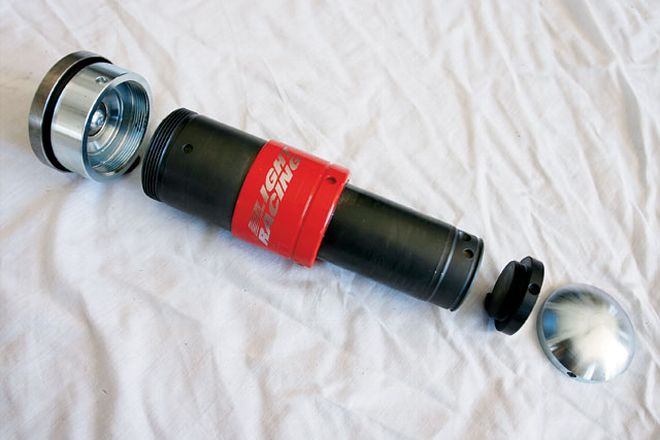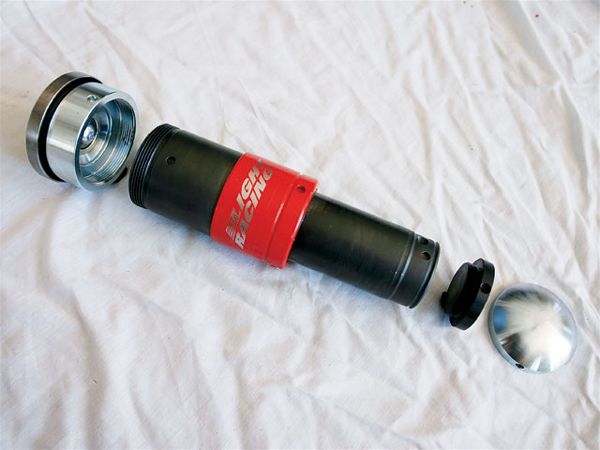
 These are the components that make up a JounceShock. On the left is one of two styles of mounts available that attach, via a thread-on design, the JounceShock body to the vehicle's frame. This mount is welded to the frame. In the middle is the JounceShock itself. They are available in two sizes: 1 1/2 inches and 3 inches of travel (shown here). The 1 1/2 is 6 inches long overall, while the 3-incher is 9 inches long overall. Both bodies are the same diameter and use the same frame mounts and feet. Below is the thread-on nylon "foot" that comes in contact with the weld-on "target" below it when the vehicle's suspension travels upwards. The feet and targets are available in corresponding convex and concave shapes to fit different applications.
These are the components that make up a JounceShock. On the left is one of two styles of mounts available that attach, via a thread-on design, the JounceShock body to the vehicle's frame. This mount is welded to the frame. In the middle is the JounceShock itself. They are available in two sizes: 1 1/2 inches and 3 inches of travel (shown here). The 1 1/2 is 6 inches long overall, while the 3-incher is 9 inches long overall. Both bodies are the same diameter and use the same frame mounts and feet. Below is the thread-on nylon "foot" that comes in contact with the weld-on "target" below it when the vehicle's suspension travels upwards. The feet and targets are available in corresponding convex and concave shapes to fit different applications.
When it comes to suspension design, proper spring rates and great damping are essential to maintaining control at faster speeds. Faster speed over rough terrain creates more suspension movement, and eventually you run out of it. It is just before this bottom-out point that a secondary suspension system is crucial to vehicle durability/survivability and a fluid ride that doesn't compress your spine into that of a midget.
A secondary suspension, usually a rubber bumpstop, is utilized in almost all OE suspension systems. While OK for street use, when subjecting a vehicle to rough off-highway abuse, the limitations of a chunk of rubber become readily apparent. This is where Light Racing's new JounceShocks come into play.
The JounceShock is a nitrogen- and oil-charged cylinder and shaft that, when properly installed, only comes into play during the last one half to one third of your vehicle's suspension travel. The body of the JounceShock is attached to the vehicle's frame, while a "target" or contact pad is attached to the moving axlehousing (live axle application), or lower control arm (IFS or IRS application). When the suspension nears its maximum upward travel, the target comes in contact with the moveable shaft of the JounceShock. The suspension's upward force pushes the shaft into the J'Shock body, which is filled with nitrogen and a bit of oil. Via valving, the shaft compresses the nitrogen, causing its pressure to increase dramatically since the cylinder is small and the travel of the shaft is 1.5 or 3.0 inches, depending on application. The increased pressure absorbs the force of the upward traveling suspension as a smooth exponential increase in force instead of a force spike which would occur if the suspension went metal to metal. (Read: painful spine compression.)
Once the upward travel energy is absorbed by the valving in the JounceShock, the suspension will rebound in the opposite direction (the speed of which is controlled by the regular shock absorber). Meanwhile, the valving inside the JounceShock doesn't allow it to rebound as fast as the suspension, so it doesn't contribute to pushing the suspension back out (like a rubber bushing will). This energy dissipation is one of the key reasons JounceShocks are so effective in controlling a vehicle when it's driven at high speeds over rough terrain.
Since a JounceShock is not engaged until the end of a vehicle's suspension travel, on-road ride quality and ride height are unaffected. However, handling with a heavy payload can be improved if the suspension squats enough to engage the JounceShocks during sharp cornering or big bumps. Once off-pavement and driven at speed, your rig will feel like it never bottoms out and it will bounce around less. Care must be taken, as this added suspension capacity can mislead one into thinking the overall vehicle is now stronger and can take blows like a Trophy Truck. An example of this came when the military was testing otherwise-stock GM trucks equipped with J'Shocks for use as Border Patrol rigs. The ride was so good, they unknowingly beat the trucks so hard that their frames spread and the engines fell out of the bottom of them!
So all this is great for going fast, but why put them on a rockcrawler? Well, if crawling rocks is all you do with your rig then yeah, they would be unnecessary. However, I like my rig multifunctional. It's more of a dual-sport rig these days that can go fast or slow. The beauty of JounceShocks is that, for slow rockcrawling, they don't have any negative effect. I haven't noticed any change or limitation in articulation during extreme flex, and in fact, it feels more stable when completely twisted up or when climbing walls where the weight transfer is heavily rearward.
JounceShocks are available in a universal application. Light Racing also has developed specific kits to attach them to Toyota Tacomas, 4Runners, and the new FJs, as well as late-model F-150s and GM pickups. More applications are under development, including TJs and the new JKs. Pictures better explain the several clever ways J'Shocks are mounted, so check out the photos. And if you're ready to go faster in your rig, don't forget that all-important secondary suspension that takes the shock out of your jounce.








